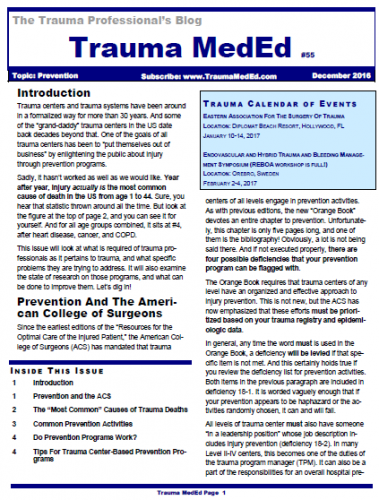Elderly falls have become a huge problem. There isn’t a night that goes by that we don’t admit at least two or three at our trauma center. There are at least a dozen factors that have been identified that are associated with falls, including:
- Medications
- Bone and muscle loss
- Underlying medical conditions
- Gait problems
- Throw rugs and other environmental hazards
- Visual problems
And many more! But let’s focus on that last one. Vision problems can be due to primary disease, such as glaucoma, or from lack of adequate correction of those problems, such as decreased visual acuity.
The group at West Virginia University is presenting a prevention paper next week. They prospectively studied patients older than 60 years who were admitted to their trauma service over a one year period. They wanted to determine the prevalence of undertreated or undiagnosed eye disease in the population, and to find out if using readily available screening tests could detect this and assist in prevention efforts.
A dilated ophthalmic exam was performed and used as the gold standard. The results were compared to a screening app administered by a trauma provider via an iPad (the eyeTests Easy app). This app can be used to test for visual acuity, macular degeneration, near vision, and astigmatism.
Here are the factoids:
- A total of 96 patients were enrolled, with an average age of 75 and a predominant mechanism of fall in 79%
- Significant abnormal vision was undiagnosed in 39% of patients and undertreated in 14%
- The trauma provider app exam was 94% sensitive and 92% specific
- Correlation was best on pupil exam (86%), visual fields (58%), and the macular degeneration test (52%)
- A combination of visual fields and the Amsler grid were associated with significant abnormal vision
The authors concluded that unrecognized visual problems are common, and are present in 53% of their elderly trauma admissions. They also state the the trauma provider exam can identify abnormalities in “most cases” and can identify those who should be screened by an ophthalmologist.
My comments: This is an interesting study that compares a simple, app-based screen with a more sophisticated ophthalmology exam. However, it is not clear what “significant abnormal vision (SAV)” really is. The sensitivity and specificity numbers cited depend on this definition. Is it a positive answer to one of the screening questions? Evidence of macular degeneration? If so, how much? I’m sure that a lot of the elderly (and younger) population have some small irregularities in their vision, but what makes it significant?
The study does show that the app can be used as a screening tool due to the congruence with the “gold standard” ophthalmologic exam. And given that vision is one of the major factors associated with falls risk, it may be a cost-effective tool for reducing it.
Here are my questions for the authors and presenter:
- What is you exact definition of “significant abnormal vision?” This is critical, because it determines the significance of the rest of your results. If the threshold is set too low, you will detect many anomalies but they may not be clinically significant. This definition needs to be as objective as possible so others can duplicate and take advantage of your work.
- What do you recommend for workflow to incorporate this tool? Who should do it and when? Should the user focus on particular portions of the app (e.g. Amsler and visual fields, acuity)?
- Describe your future plans for the longitudinal study mentioned in the abstract.
This is very interesting prevention work. I look forward to the nitty gritty details next week!
Reference: Stop the fall: identifying the 50% of geriatric trauma patients with significant vision loss. EAST 2021, Paper 11.


